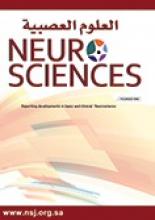Abstract
OBJECTIVE: To assess the epidemiology of healthcare-associated infections (HAIs) in a neurology unit in a university hospital.
METHODS: The study was carried out prospectively at Dicle University Hospital, Diyarbakir, Turkey (1050-bed) between 1st January 1999 and 31st December 2004. Active surveillance for HAIs was performed by the infection control team, using the criteria proposed by the Centers for Diseases Control and Prevention (CDC) and National Nosocomial Infections Surveillance System (NNIS) methodology.
RESULTS: During the 6-year follow up period, 219 HAIs episodes were detected in 203 patients out of 3323 in patients. The mean length of stay of patients with HAI was 28+/-5 days, while that of patients without infections was 11+/-1 days. Eighty-two patients died with HAIs, while 1330 died in the patients without infections. The overall incidence rates (HAI/100) and incidence densities (HAI/1000 days of stay) of HAIs were 6.6% and 4.4/1,000 patients-days. The most common HAIs by primary site were urinary tract infection (44.2%) and decubitus infection (30.4%). The most prevalent microorganisms were Escherichia coli (27%), Klebsiella species (14%), Pseudomonas aeruginosa (13%), Enterobacter species (12%), coagulase-negative Staphylococci (10%) and Staphylococcus aureus (7%).
CONCLUSION: The results may contribute to observe the magnitude and characteristics of HAIs and to plan and evaluate policies and guidelines of infection control in neurology units.
- Copyright: © Neurosciences
Neurosciences is an Open Access journal and articles published are distributed under the terms of the Creative Commons Attribution-NonCommercial License (CC BY-NC). Readers may copy, distribute, and display the work for non-commercial purposes with the proper citation of the original work.






